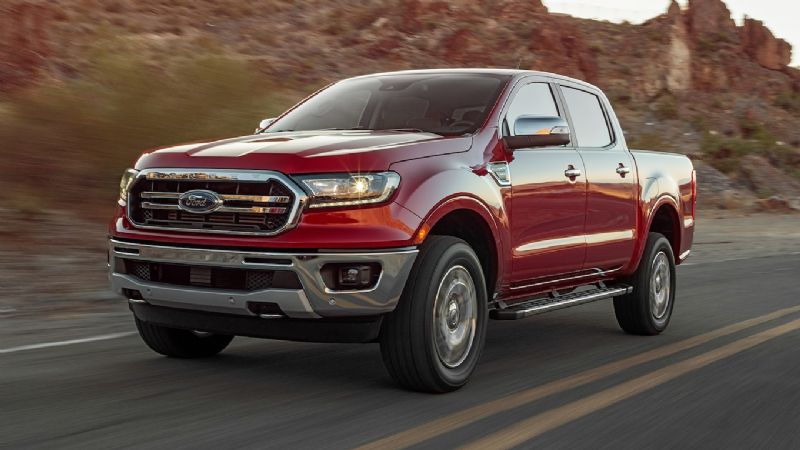2019 Ford Ranger Pros and Cons Review: What a Powertrain!

Pros: Powerful turbo-four engine Great value Towing performance Cons: Old architecture Poor interior space Aging design The Ford Ranger came back to the U.S. market after an eight-year hiatus, during which it spent time overseas instead of filling the midsize truck gap in the automakers North American lineup. Rising popularity of the Toyota Tacoma and Chevrolet Colorado forced Ford s hand, but instead of developing a truck specifically for North America, Ford simply brought the existing Ranger here. And those secondary-market roots show. By making changes to the chassis to comply with U.S. safety standards, the Ranger arrived at the end of 2018 with one engine option: a 2.3-liter turbo-four thats good for 270 hp and 310 lb-ft of torque. Read about Car, SUV, and Truck of the Year contenders and finalists HERE . That said, one of the Rangers best traits is its powertrain. The 10-speed transmission does a great job with this engine, which provides more than enough power despite its mere four cylinders. Even when we briefly towed more than 7,000 pounds, the Rangers capability impressed the judges. When towing 4,000 pounds, the Ranger Lariat was quicker than the two Jeep Gladiators and the Chevy Silverado RST four-cylinder, which all pulled the same weight. --> The engine has a ton of torque and pulls 7,200 pounds with ease, features editor Scott Evans said. No trailer brake, but it doesnt really need it. Towing performance aside, the Ranger has a few drawbacks. The fact that the truck rides on an old architecture is evident from the moment you start driving. The poor body control had judges complaining about the amount of movement in the cabin. Going diagonally over a driveway entrance feels like a tiny sailboat caught in a hurricane being tossed all over the place, Evans said. And with the steering not delivering good feedback, the Rangers handling definitely has room to improve. Check out the not-for-U.S.-sale Ford Ranger Raptor here . Sit in the Ranger XL SuperCabs second row, and youll need to visit the chiropractor immediately after. The upright seat back combined with the negligible legroom will make rear occupants complain even on short rides. It basically has two jump seats that are incredibly uncomfortable, said Detroit editor Alisa Priddle, who also had a hard time getting in the back seat, given the lack of grab handles. And although the Lariat SuperCrew has ample space for rear passengers, its cabin design is getting old. Fords Sync 3 infotainment system needs an upgrade, and Evans likened the instrument cluster to something pulled from a 2010 Fusion. The Rangers competitors arent known for their interior design, either, but Ford could have invested more money to improve the look and feel. We have similar feelings regarding the exterior. Although design isnt usually top of mind for truck shoppers, the current styling is already aging. But when judging against our criteria, we see a lot of value for the Ranger. With its EcoBoost engine and high towing capacity, even the lower-spec Rangers get strong marks. The XL 42 we tested came with a price tag of $29,445. Were not fans of its credit-card-size screen, but its utility really shines. The Ranger has all the right parts and pieces to be a strong pickup truck: Tow/Haul mode, huge real-world payload capacity, it tows like a champ (not an easy thing at this size), and is easy to maintain, guest judge Mark Williams said. But the Ranger fell short against the rest of our criteria. Rumor has it Ford is already working on a new Ranger for the U.S. market, and its supposed to arrive in the next four years. If Ford could get this engine and transmission into an American-grade platform, senior features editor Jonny Lieberman said, it would have a terrific truck on its hands. We cant wait to see what comes next. 2019 Ford Ranger XL STX (SuperCab 2WD) Lariat (SuperCrew 44) Base Price/As Tested $27,625/$29,445 $39,760/$44,465 Power (SAE net) 270 hp @ 5,500 rpm 270 hp @ 5,500 rpm Torque (SAE net) 310 lb-ft @ 3,000 rpm 310 lb-ft @ 3,000 rpm Accel, 0-60 mph 6.3 sec 6.7 sec Accel, 0-60 mph (loaded) 7.1 sec* Not tested Accel, 0-60 mph (towing) 12.5 sec** 12.9 sec** Quarter Mile 14.9 sec @ 92.9 mph 15.2 sec @ 90.5 mph Quarter Mile (loaded) 15.5 sec @ 89.1 mph* Not tested Quarter Mile (towing) 19.1 sec @ 72.4 mph** 19.2 sec @ 70.6 mph** Braking, 60-0 mph 125 ft 122 ft Braking, 60-0 mph (loaded) 138 ft Not tested Double Lane Change Time 3.7 sec 3.6 sec Davis Dam Frustration 8.1 sec @ 529 ft*** 9.4 sec @ 618 ft*** Cruise Control 65-mph Overrun 4.0 mph 1.1 mph EPA City/Hwy/Comb 21/26/23 mpg 20/24/22 mpg Key * 1,000-lb payload | ** 4,000-lb trailer *** 35-55-mph uphill acceleration with a 3,160-lb trailer The post 2019 Ford Ranger Pros and Cons Review: What a Powertrain! appeared first on MotorTrend .
http://www.motortrend.com/cars/ford/ranger/2019/2019-ford-ranger-pros-and-cons-review/




